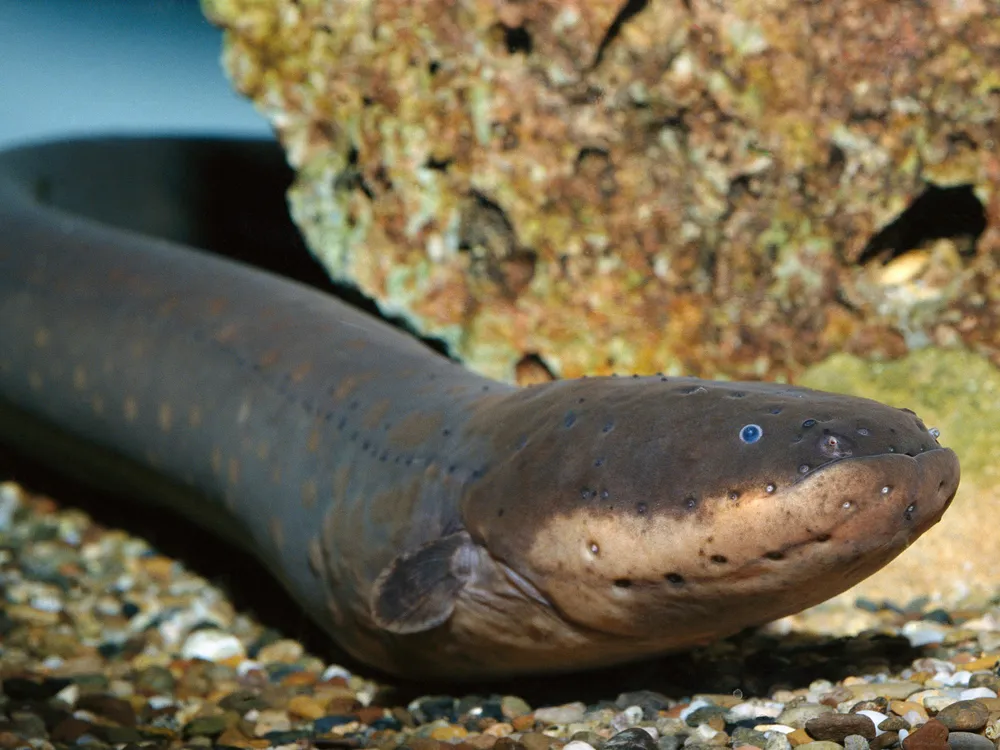By Fanis Michalakis,
Electric eels (Electrophorus genus) are three species of freshwater fish that live in the northern part of South America. They get their name from their ability to produce electricity to stun their prey or to ward off potential predators. Despite their name and appearance, they are more closely related to catfish and carp than other eel species, and they are related to other electric fishes, some of which produce weak electric currents for electrolocation while others produce powerful shocks, or they can use both like the electric eel.
Fish have the lateral line organ that they use to sense changes in water pressure and locate their prey by their movements. Electric eels have electroreceptors that derive from the lateral line organ with high-frequency receptors for hunting other fish. They also have three pairs of electric organs that produce two kinds of currents: low voltage currents and high voltage currents. The low voltage currents give the fish its electrolocation ability while the high voltage current is used in rapid fire for hunting and defence and more isolated charges have been recorded when the electric eel hunts in complex environments. These organs consist of electrocytes, modified muscle cells that make up more than 80% of its body and can produce rapid discharges of 600 volts! The reason behind the high voltage is the environment. Because they live in freshwater environments, the water has high resistance to electricity, and as a result electric eels need to produce higher voltages to produce effective shocks. We are not sure why electric eels have three electric organs but only produce two kinds of currents. It has been suggested that there is a third current with a voltage between the other two that is produced after the low voltage current and before the high voltage one and functions for the coordination of the body, but that theory needs further testing.

Electric eels appear to be at the top of their food chain, with no known predators yet because their shock is enough to deter much bigger animals (even the size of a horse). The are carnivorous animals feeding on other fish, crustaceans and sometimes amphibians, based on the stomach contents of some samples.
The mechanism behind their hunting method has only recently been studied, with an experiment in 2014 by Kenneth Catania showing the changes in discharge and behaviour during the hunt. The electric eel began the attack with rapid volleys of high voltage charges which causes involuntary muscle contraction to its prey, leading to immobilization, after which the electric eel would strike to feed. In another experiment Kenneth Catania “hid” the prey behind a thin layer of agar. The eel would send a doublet or triplet of high voltage currents (the ones that they send isolated) which would cause the prey to twitch and allow the eel to spot it and attack. This means that they use their electricity to their advantage not just to immobilise prey, but also locate it when it hides. The researchers repeated the experiment and every time the pattern was the same. The eel sent the high voltage current and then paused, waiting for a response by the prey before attacking. When the prey was isolated so the current could not provoke involuntary movement, they eel didn’t attack, but it did when the prey was artificially moved without the use of the predators’ charges. This means that the electric eel waits for a response to check if there is any prey in the area and if the prey is alive. Once caught, the prey can’t escape because the eel curls, causing the tail to touch the prey as well, delivering more charges which will eventually wear out the prey.
Early experiments on electric eels gave us a story that serves no purpose to the biology of the fish but it is a fun fact. Alexander von Humboldt wanted to study electric eels, so fishermen gave him some that were poisoned by plant roots and could not be used for experiments. The second batch was collected by hunting with horses. This process is cruel for the horses. The fishermen forced the horses to enter the shallow waters and the horses would start to panic and jolt. The movements would provoke the electric eels to attack the horses by leaping and attacking them on their bellies. By forcefully repeating the process the eels would tire themselves out and would be easily collected by the fishermen at the cost of some horses drowning. Although there is no evidence that this event happened, there is no reason to believe it didn’t. Later experiments showed that electric eels when threatened by big predators would show that kind of behaviour and their charges are strong enough to stun a horse.

As of today, electric eels are not threatened according to the IUCN. There are several videos of electric eels in tanks as pets, where the owner would place the hand in the tank, sometimes without rubber gloves. Even if they don’t touch the animal, I can’t stress how dangerous this is. One jolt could lead to a connection and subsequent charge. Although isolated attacks on humans are not lethal, repeated exposure could lead to heart problems. It is essentially playing with fire.
References
- Electric eel. a-z-animals.com. Available here
- Kenneth Catania, The shocking predatory strike of the electric eel.Science 346, 1231-1234 (2014)
- March 19, 1800: Alexander von Humboldt Hunts Electric Eels. aps.org. Available here
- Catania KC (2019) The Astonishing Behavior of Electric Eels. Front. Integr. Neurosci. 13:23.




